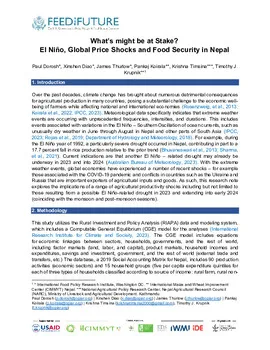What’s might be at Stake? El Niño, global price shocks and food security in Nepal

Abstract
Over the past decades, climate change has brought about numerous detrimental consequences for agricultural production in many countries, posing a substantial challenge to the economic wellbeing of farmers while affecting national and international economies (Rosenzweig, et al., 2013; Koirala et al., 2022; IPCC, 2023). Meteorological data specifically indicates that extreme weather events are occurring with unprecedented frequencies, intensities, and durations. This includes events associated with variations in the El Niño – Southern Oscillation of ocean currents, such as unusually dry weather in June through August in Nepal and other parts of South Asia (IPCC, 2023; Rojas et al., 2019; Department of Hydrology and Meteorology, 2018). For example, during the El Niño year of 1992, a particularly severe drought occurred in Nepal, contributing in part to a 17.7 percent fall in rice production relative to the prior trend (Bhuvaneswari et al., 2013; Sharma, et al., 2021). Current indications are that another El Niño – related drought may already be underway in 2023 and into 2024 (Australian Bureau of Meteorology, 2023). With the extreme weather events, global economies have experienced a number of recent shocks – for example those associated with the COVID-19 pandemic and conflicts in countries such as the Ukraine and Russia that are important exporters of agricultural inputs and goods. As such, this research note explores the implications of a range of agricultural productivity shocks including but not limited to those resulting from a possible El Niño-related drought in 2023 and extending into early 2024 (coinciding with the monsoon and post-monsoon seasons).
